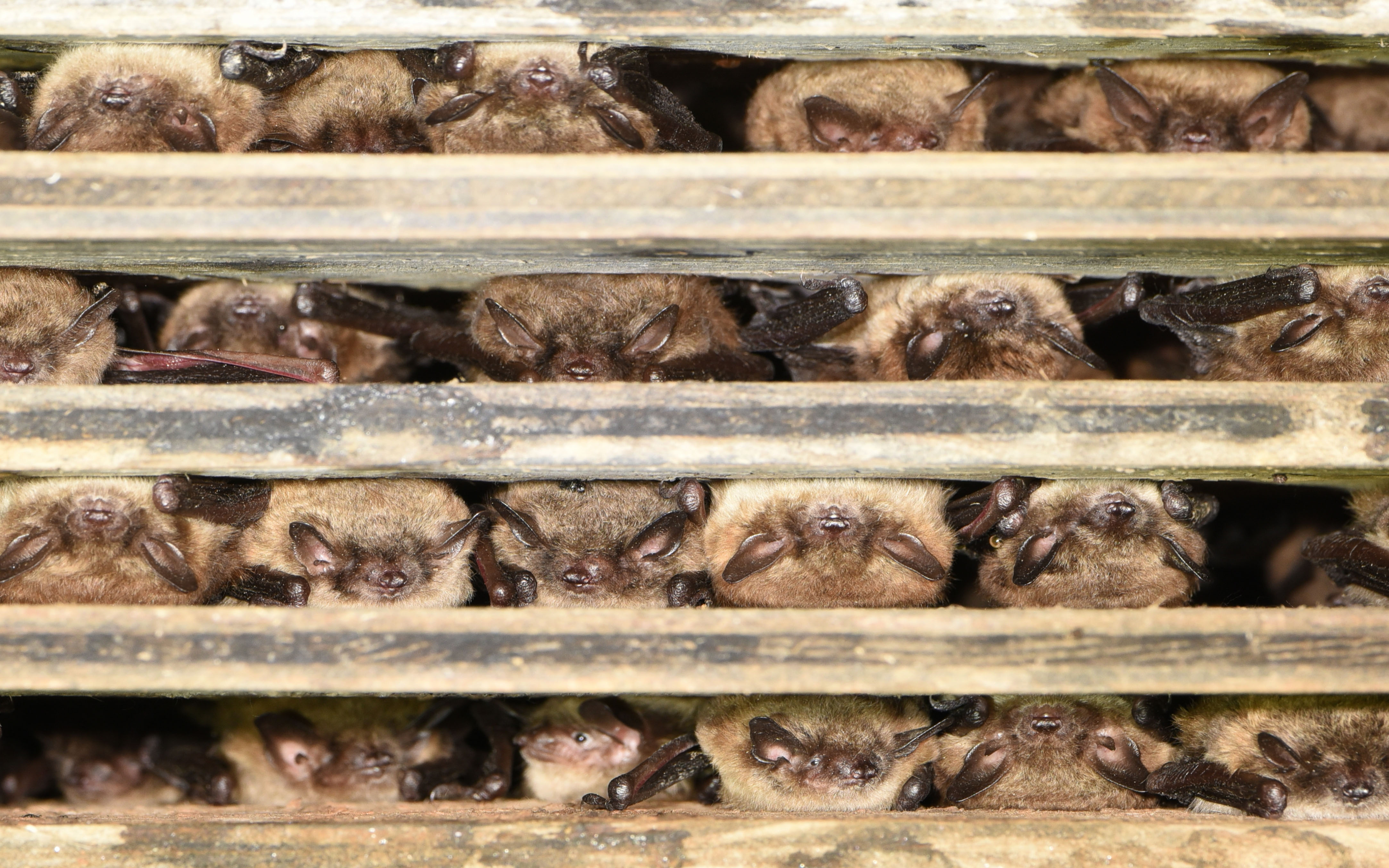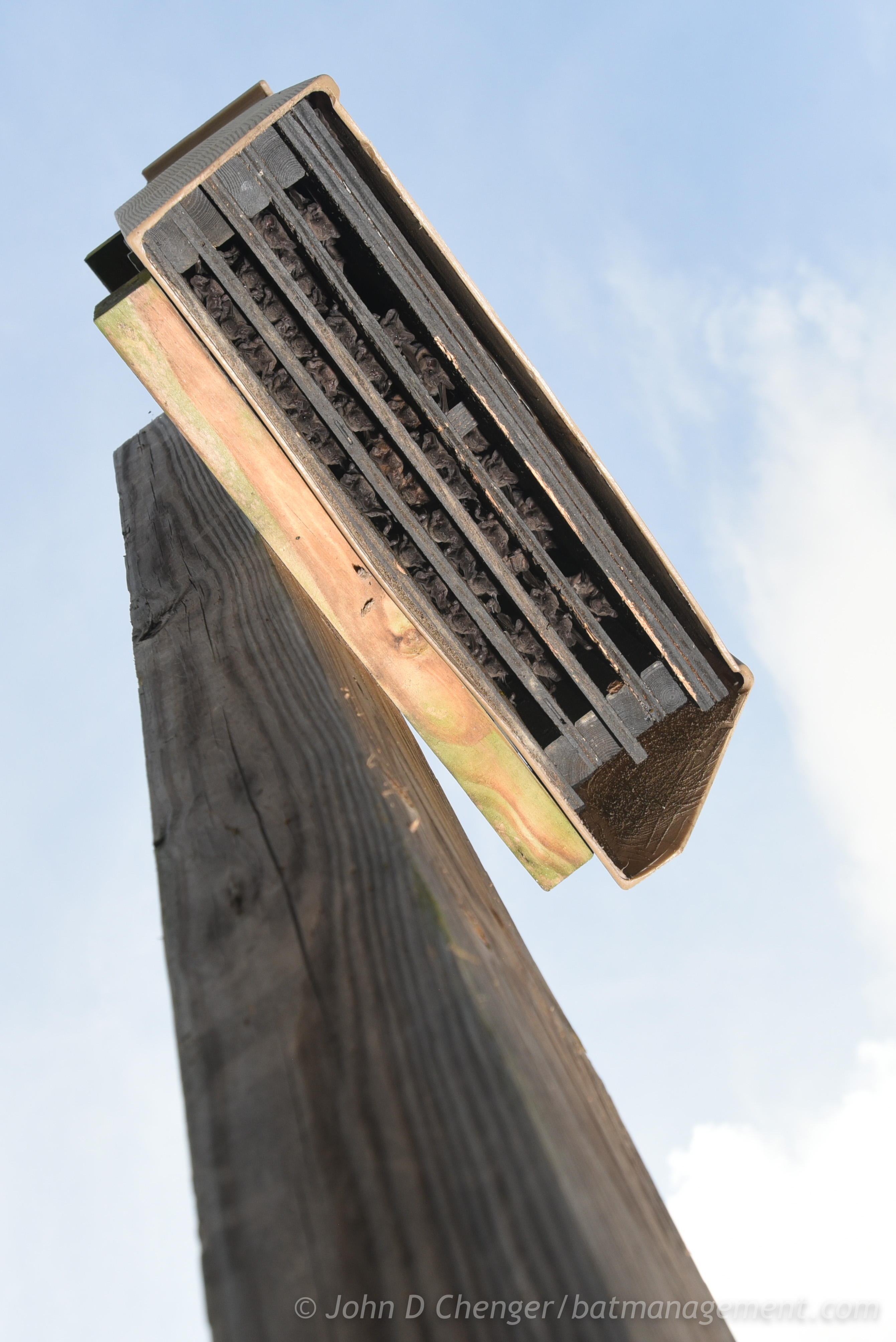
Bat houses can be checked for occupants in two ways. The most direct approach is to stand under, but off to the side of the bat house and view the interior using a powerful spotlight (photo at right). This is best done in morning or late afternoons when the sun is not as blinding. Inspections should be done sparingly throughout the first season of occupation, if bats are present. Be careful not to mistake wasp nests for a bat; binoculars or a camera with a powerful optical telephoto lens may help. Once occupied keep inspections bi-weekley or monthly or so. Usually all the bats will be relatively visible, although there may be additional bats above the first ones seen.
Bats cannot be easily viewed directly inside some bat houses such as the Super Rocket Roost. In this case a less intrusive technique is to quietly watch the evening exit, which begins approximately 15 minutes after local sunset and lasts up to thirty minutes. Do not shine lights on the bat house but bats can easily be seen and counted silhouetted against the sky.
Certain trail cameras can successfully capture video clips of bat activity entering a bat house throughout the morning (see Super Rocket Roost video below). Set the camera on a stand about 6'-10' away and just below the bottom of the bat house to avoid dew collecting on the lens. The camera should be set to infrared night video mode and ~20 second clip lengths. Generally a bat will trigger the recording start but because of the bat's speed, it will be the subsequent passes or activity that is recorded. These cameras generally do not record the bats -emerging- your bats house, but do a fair job recording the re-entry throughout the night.
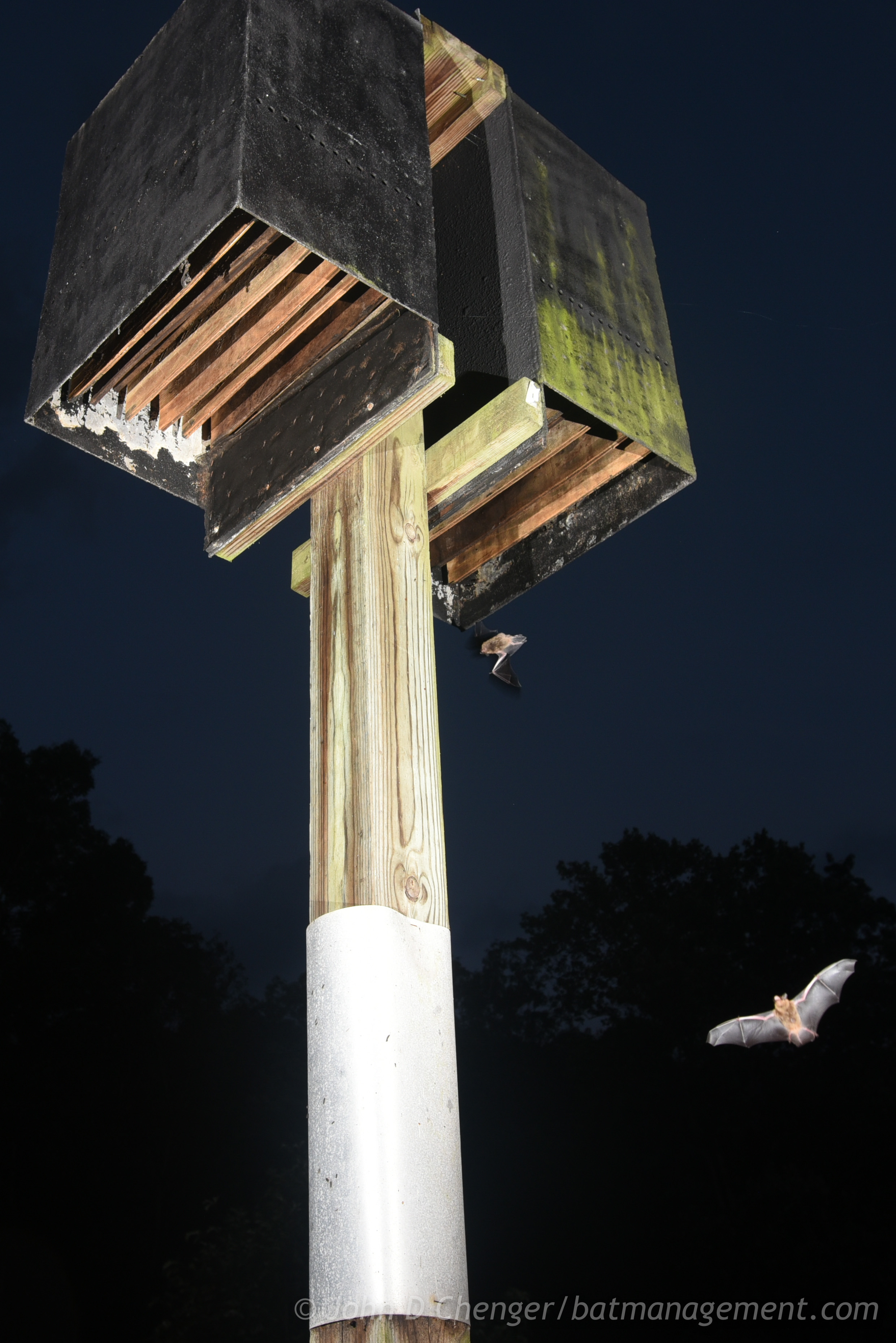
On a very rare occasion, a snake may climb a post and enter a bat house. Fortunately most BCM bat houses feature an attic space which allows bats to escape into adjoining baffles. We have video of a mouse entering a bat house, though it may have been looking for insects rather than bats. Other predators such as raccoons and cats may cause a problem, less though if the bat house is mounted high and there are no perches (tree limbs, etc.) provided nearby in the bat exit swoop zone. Nevertheless, consider a predator guard if your bat house attracts a large number of bats, which may in turn attract ground-based predators. You may not be able to prevent all predation, particularly from raptors at dusk. However, be careful not to provide an unfair advantage to predators such as installing bat houses too low, on trees, or near other structures that predators may be able to perch on.
At right: a very simple predator guard might be 2' high aluminum flashing at least 3' above ground wrapped around a post. Use 4'' spacers (not shown) in the upper half between the aluminum and the post and seal the top. This creates a void around the pole that will deter snakes.
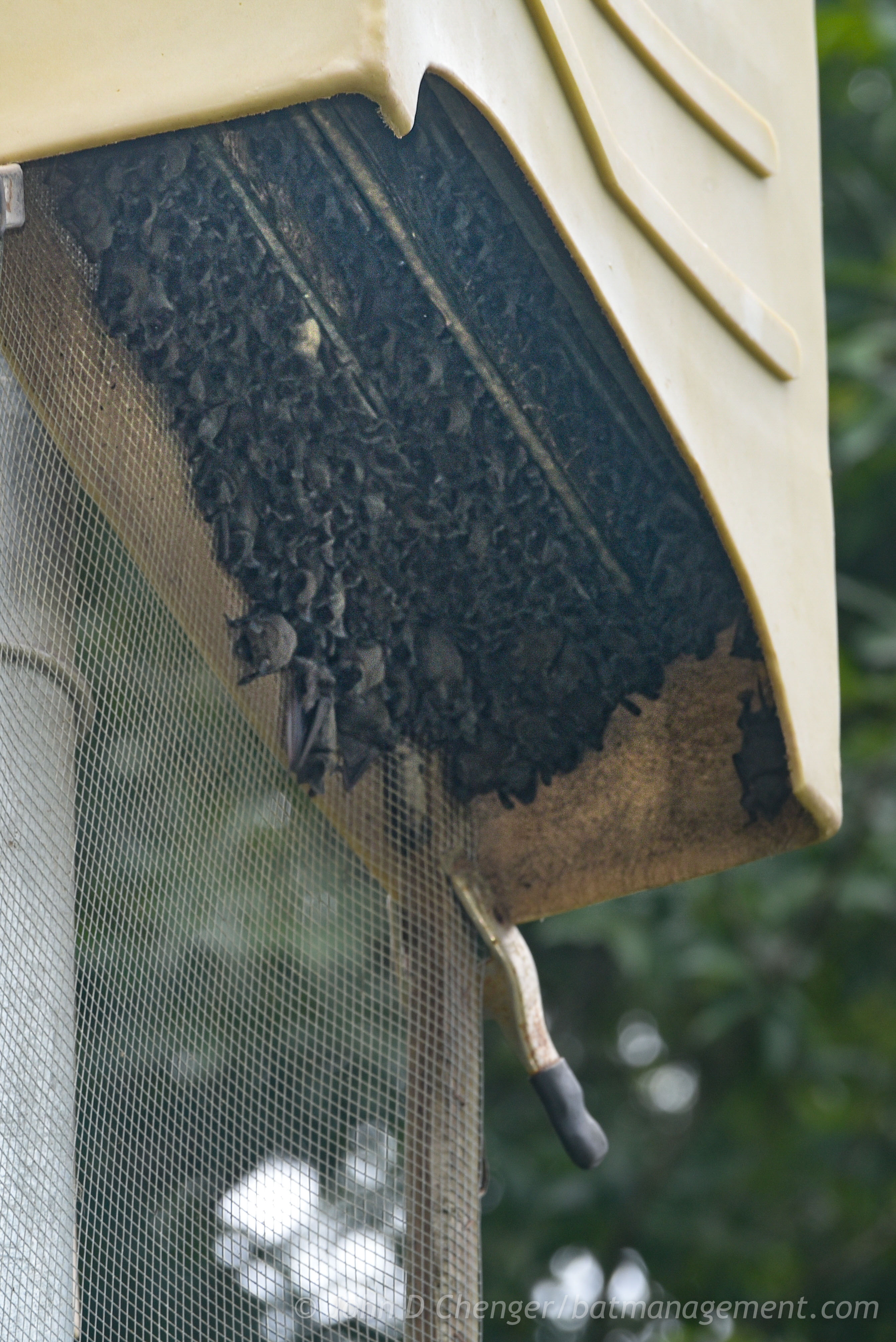
Our bat house color and sun exposure suggestions are assuming you are starting out with no bat colony. When a large number of bats take over a bat house, it can become too hot. If bats are always seen at the bottom of the baffles, it is possible that the box is receiving too much heat or is simply overcrowded. In extreme cases pup may fall out.
The easiest solution is to drill 1/2’’ holes around the bat house (including the back) 1/3 up from the bottom. Another suggestion is to add a second bat house on the backside of the first. You should cut a pass-through 1/3 up from the bottom of each bat house and perhaps enclose the sides. This will provide bats with a cooler option right around the corner.
Another possibility is to install another bat house nearby, such as around the corner of a structure or up under a shaded eave, or somewhere on the property that is more shaded in the afternoon. In the hottest areas, bat houses can be partially shaded with an overhanging reflective tin roof. This allows the bat house to warm up in the mornings but is shaded at the hottest time of the day. A black roof could be repainted white for chronically hot locations. Bats are -very- site loyal and will continue to occupy the roost throughout this process. If all bats leave in the evening, you can even retrofit the bat house at that time if desired.
BCM bat houses all have rear exit vents, which when used with our mounts, allow bats to roost behind the bat house in a cooler chamber we call the Perch Panel.
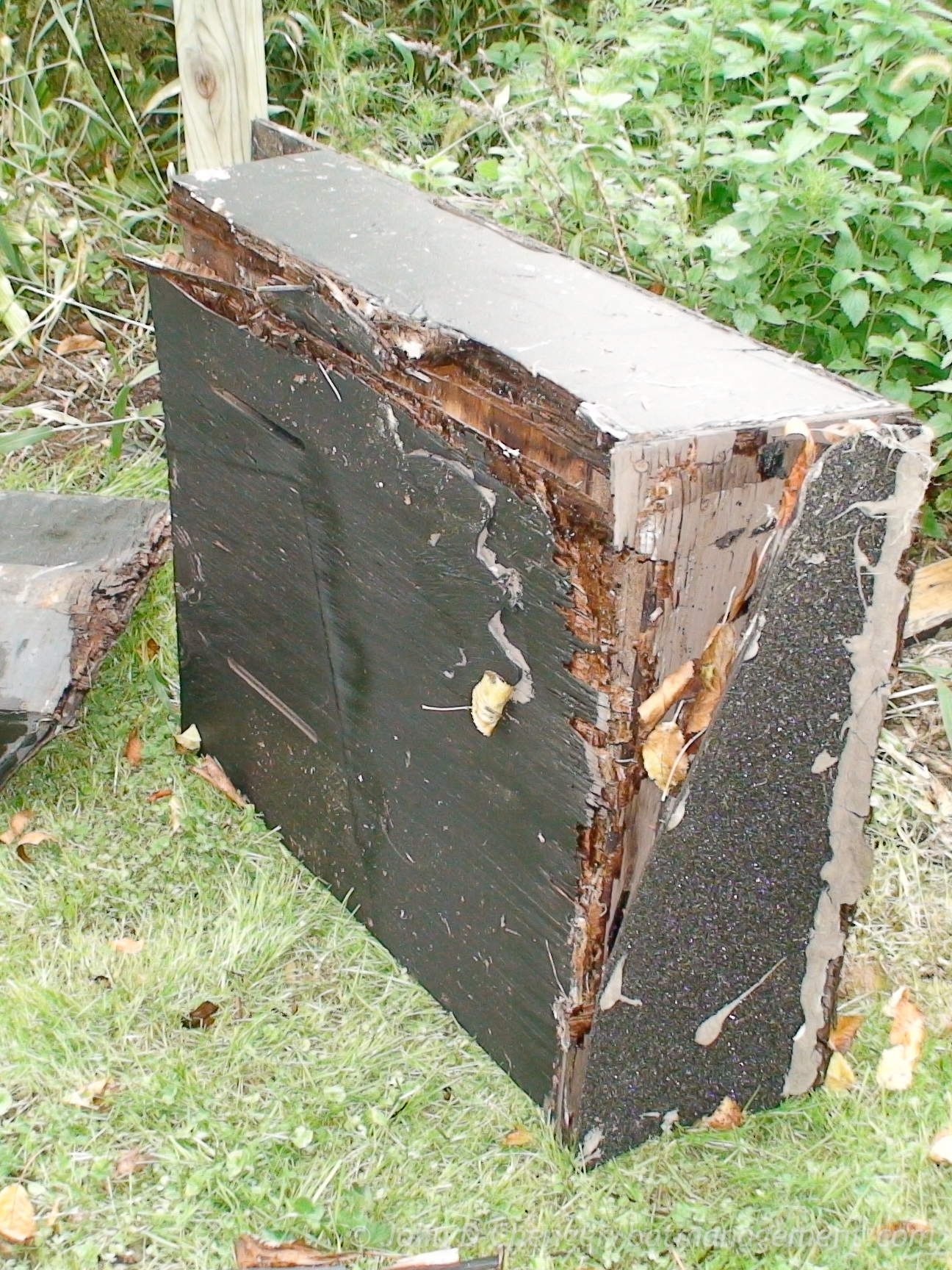
BCM Bat houses require little maintenance once installed. However, they are exposed to the elements (and to other wildlife) so they need periodic attention. Most maintenance is best performed when bats are not present. Look up into the bottom of the bat house, looking carefully for broken seams or other cracks that will cause drafts and prevent the house from holding heat. Weathering from seasonal temperature changes can cause joints to separate after a few years. Daylight entering around the roof is a sure sign of needed repair, but be careful not to mistake broken seals with normal daylight entering through the vent, or possibly filtering thru the tan plastic of a ColonyLodge. If left in disrepair, bats may abandon or never utilize a drafty roost. A ladder can be placed against a post-mounted bat house in order to apply fresh sealant over all seams. Re-staining or re-painting the bat house every few years will prolong its life and help to seal micro-crevices in the wood and joints. When bats vacate the box in the fall for their wintering sites, that is the perfect opportunity to perform any needed maintenance. Many temperate species of bats in the U.S. move between warm summer roosts and cold, but not freezing, cave roosts where they hibernate in the winter. Some sub-tropical species live in northern latitudes in the summer and migrate to more southerly locations where they can stay active and find enough insect-food all winter long. Because bats are very loyal to their summer (and winter) roosts, they will happily return to their re- furbished bat houses in the spring. Brazilian free-tail, Southeastern myotis, evening bats, and Florida bonneted bats will use bat houses in the Gulf Coast states year-round, so check carefully for occupants even in winter!
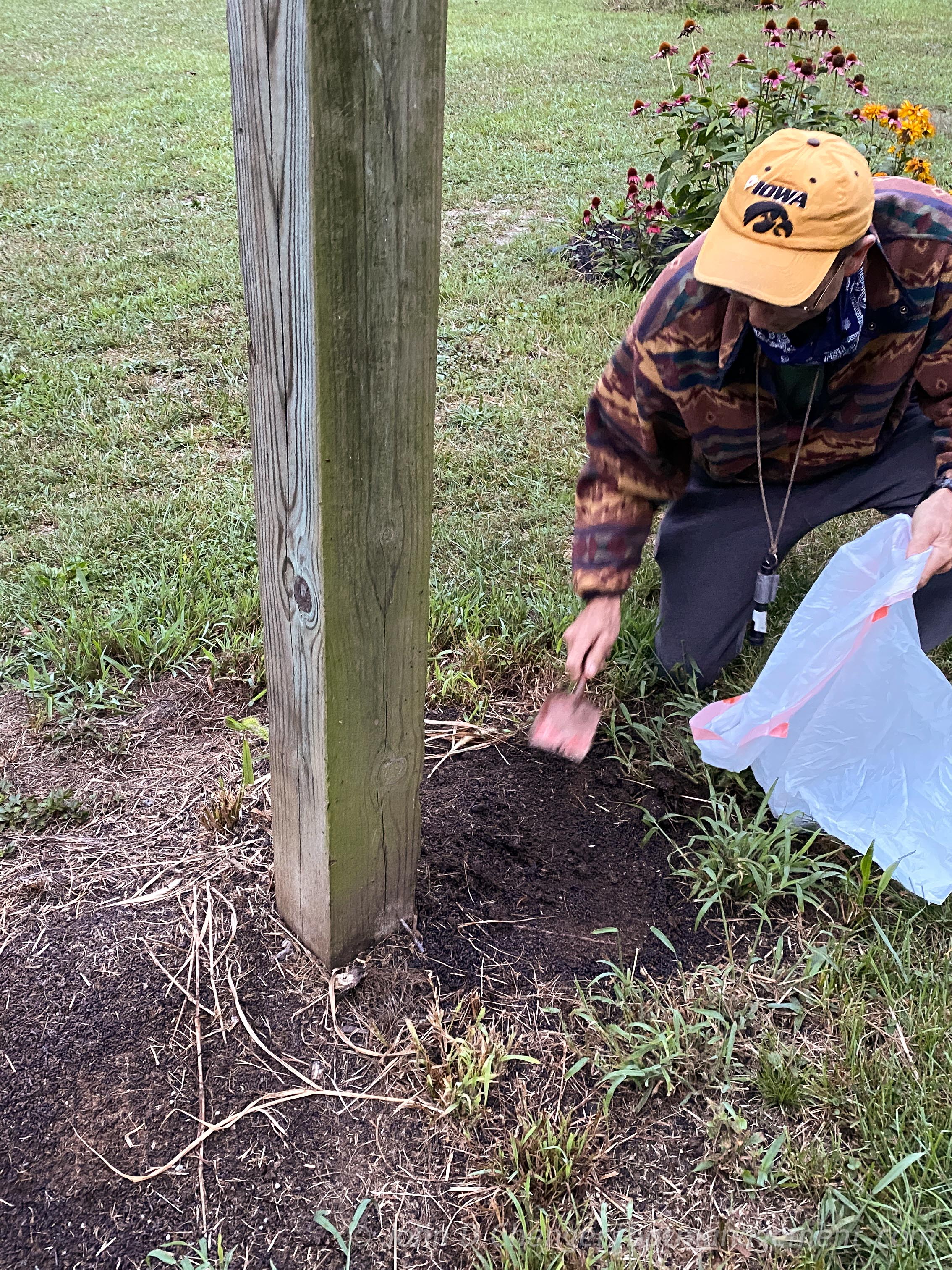
Open-bottomed bat houses like all from BCM are self-cleaning. Droppings accumulate on the ground directly under the bat house. This material naturally biodegrades and there is not much need to remove it.
Guano is high in nitrogen and makes an excellent fertilizer. It has been mined for centuries from large bat caves for this purpose, prior to the advent of chemical fertilizers. Bat house owners can collect guano from beneath houses and scatter it in gardens. Too much guano will “burn” plants though, so be careful and be aware that letting large piles sit in one area will kill grass and other plants.
Repeated exposure to old guano dust with mold possibly can be harmful to certain individuals, so avoid breathing in airborne particles in enclosed environments. Consider wearing an appropriate mask if engaged in an activity such as cleaning an old attic space where there is/was a bat colony.

Woodpeckers may drum on wood posts and bat houses creating holes in the roof or front. Repair damage by filling holes with fresh sealant when bats are not present. A more permanent fix is wrapping the bat house with aluminum trim coil flashing which can be obtained in various colors at hardware stores.
Paper wasps form gray honeycomb-shaped nests on the ceilings and in crevices of bat houses. These insects are not aggressive and happily coexist with bats. Unfortunately, if the nests become large they will eventually consume real estate inside the bat house. It is best to remove nests in the winter using a long, thin rod or stick when bats (and wasps) are not present. Check carefully before cleaning, shadows can hide solitary bats in what first appears to be an empty box.
Yellow Jackets and Hornets are very aggressive and build conical nests that can be as large as volleyballs. BUT- some may also build nests inside the bat house. If a number of insects are seen routinely entering and exiting the bat house in the summer, chances are it is overrun with yellow jackets. Bats will abandon a bat house if these insects take up residence. Destroy nests early before they become large by carefully knocking them out at night. If chemical spray is used, flush out the insecticide later with a garden hose, being careful the water doesn't reflect onto yourself.
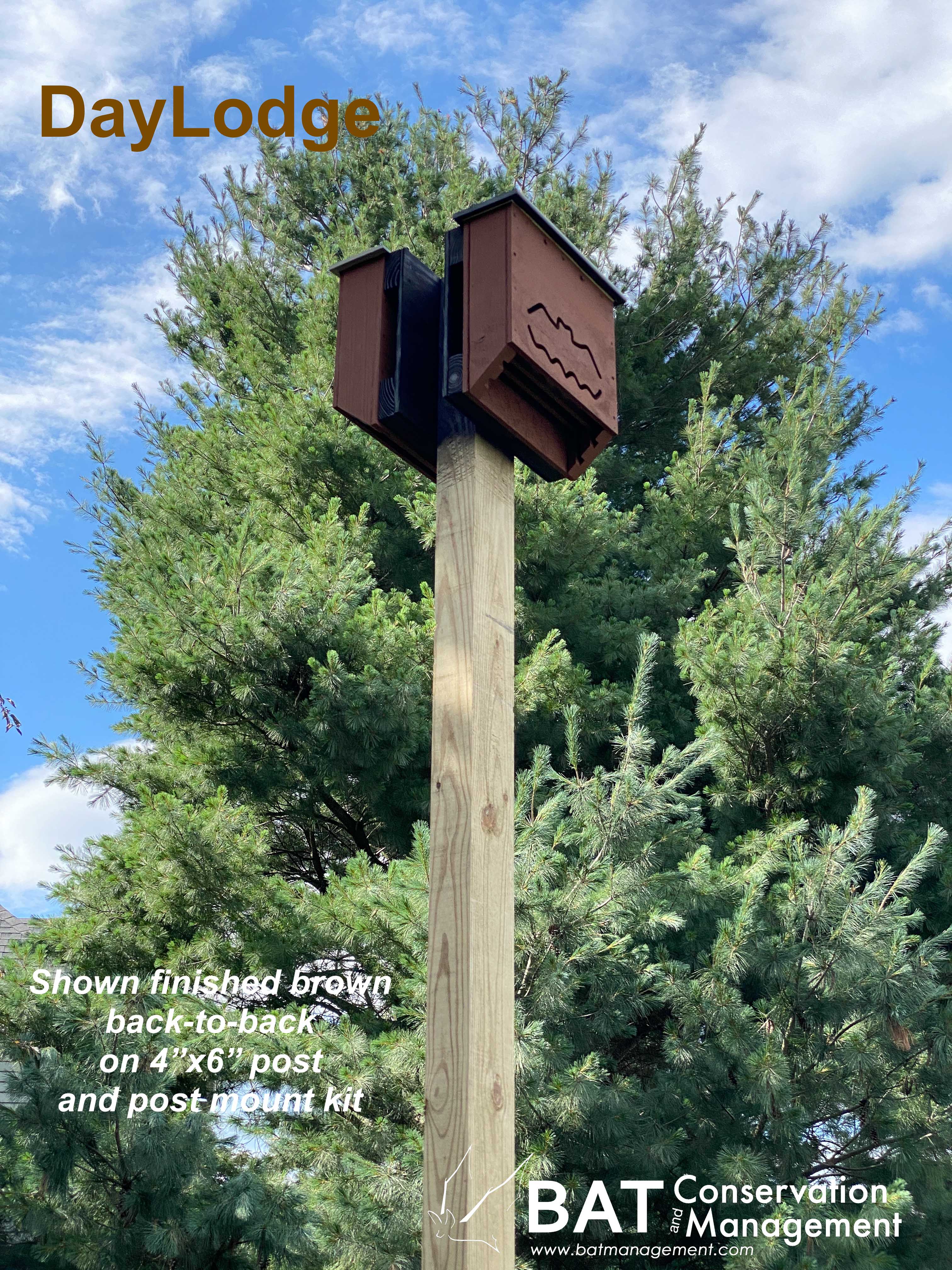
It is easier to attract bats throughout the season by using two bat houses back-to-back on a single post. If boxes are oriented southeast and northwest, they will provide a range of temperature options and make it more likely that a particular profile is attractive to bats all season long. Similarly providing several bat houses mounted in various locations with different solar exposures or colors is a great idea for starting colonies in new areas. You may find bats prefer a certain location or color and therefore over time the other bat houses can be modified similarly. The inexpensive DayLodge and DayRoost bat houses are ideal for this experimentation.
Curious bat enthusiasts can monitor the temperatures inside bat houses in several ways. An inexpensive solution is an outdoor thermometer with an external probe. The probe can be attached to a long, thin pole or stick and inserted up through the baffles and into the top of any bat house. A more elaborate, detailed study can be made using temperature data loggers available as brands such as Kestrel, Ibutton, Onset, and many others. These sensors can be left inside a bat house for months while recording temperatures at user-defined intervals. The data can then be off-loaded to a computer and graphed. Generally, the target temperature for bat houses used by little brown bats (Myotis lucifugus) is 95°F. If a bat house consistently does not reach or occasionally exceed this temperature in the summer, the box may not be airtight, may be painted the wrong color, or may be installed in a shady location.
Backyard Bat Houses
Learn the differences between our base bat houses suitable for starting backyard bat colonies.
Siting and Color
Consider the options on where to locate your bat house so it's good for bats and -for you-.
Installing a Bat House
Trees, buildings, or poles?
Installing a bat house on something high can be a job, here are suggestions on how to move it along.
Maintaining a Bat House
Our bat houses are low maintainance, but there are some long term situations to be aware of.
Human Health Concerns
Bats attract more than their fair share of negative press, here are some facts to help prospective bat landlords rest easier.
Can my bat house be too hot?
Advice from real-world experts on how to recognize when is too hot, when to be concerned, and how to mitigate.

